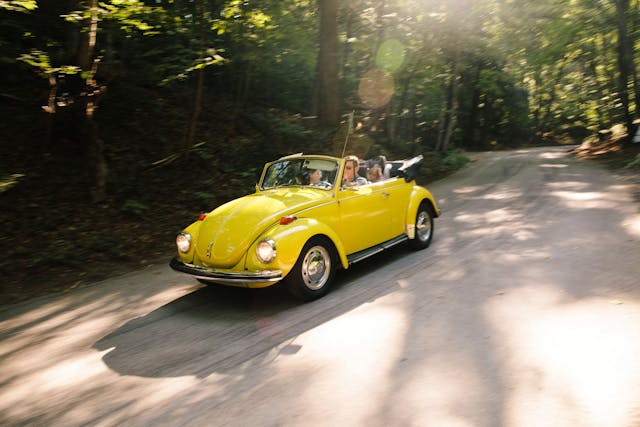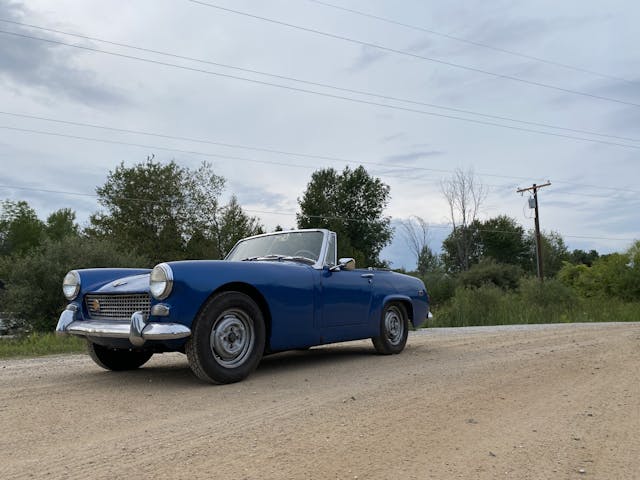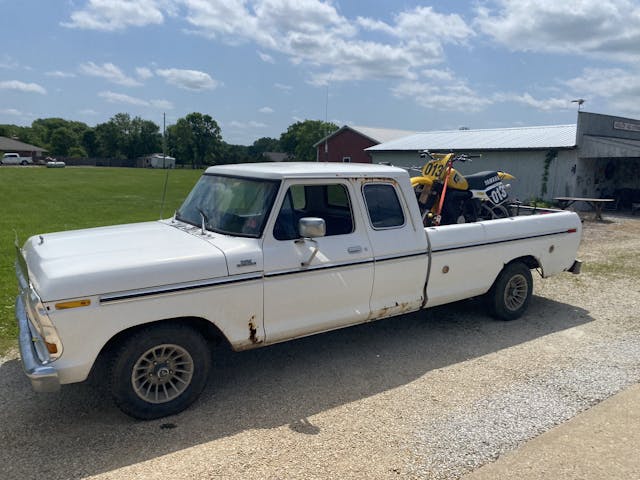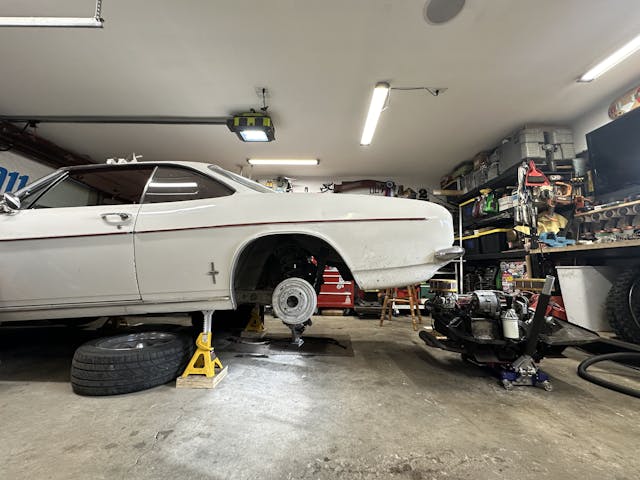Media | Articles
5 Fantastic First Project Cars
When it comes to a project car, it’s best to dive into one that truly lights a flame inside you. A project car is almost always mentally, physically, and financially draining at some point in your relationship with it. If you don’t care to stick it out through such hurdles, frustration might block you from ever returning to the project again.
So, where to begin? The list of needy cars for sale from the world’s garages, carports, driveways, and open fields can seem overwhelming. It can be easy to dream big. Of course, hell-on-wheels traps exist; certain cars are difficult to source parts for, offer minimal community and owner support, or are just plain prone to breaking.
Some cars, on the flip side, offer a stronger foundation for novices. Today we’ll be donning the role of Car Matchmaker. Whether you’re new to the hobby or a veteran, smoother-sailing and joy-to-own DIY classics are out there— here are five vehicles we think might be right for you:
Little British Cars
A cheap British sports car can offer plenty of, uh, opportunities to bond with the mechanically inclined owner. The nice thing is that there were tens of millions of Austin-Healeys, Triumphs, and MGs produced during the 1960s and ’70s that share much in terms of maintenance parts and techniques. The cars are relatively affordable, and thus, so are the parts. The biggest boon: support and knowledge provided by other enthusiasts. British car clubs are often large and helpful—perfect for a newbie to the genre.
Volkswagen Beetle

The Beetle dethroned the Model T for the outright model sales record, eventually going on to account for over 21 million sales. There is safety in numbers, which often correlates with good parts support and pricing. The aftermarket support for Bugs is downright impressive, even compared with other mainstream vintage cars like Mustangs or Chevelles. Beetle owners will get familiar with regular maintenance like oil changes and valve adjustments, but the fundamental build and design are sturdy; if you do the job right the first time, you likely won’t have to do it again unexpectedly.
Marketplace
Buy and sell classics with confidence
Ford Model A or T
You want to learn the basics? Then buy one of the most basic cars you can drive. Just stare at a Model T for more than a few minutes, and you’ll notice that none of the critical parts are hiding. Everything is pretty out in the open. Best of all, components were overbuilt by a factor or two in most areas. Model Ts—and As, for that matter—don’t require many power tools, which means they’re accessible and enjoyable to work on whether you’re a tool rookie or an experienced wrench. Fun to learn on and fun to drive? That’s a good project car.
Trucks of the 1970s and ’80
As simple as the aforementioned Fords are, their age comes with real-world usage limitations. If a utility is an aspect you value in a finished project car, vintage pickups from the 1970s and ’80s are a great place to look. These are rugged, tough hunks of metal that enjoy fairly high tolerance for deferred maintenance. If you are willing to buck up and take on the challenge of catching up on all the stuff the last owner neglected, the juice can be worth the squeeze. Fruits of your labor will include functional overdrive transmissions, disc brakes, and decent power, all baked into solid packages with relatively simple powertrains and chassis. Being trucks, they also have beds for work—or pleasure hauling. For those without a utility-focused daily driver, that’s a nice bonus when trying to justify how a collector car fits into your lifestyle.
Anything you don’t expect to daily drive
In reality, just about anything that makes you look forward to dirty hands and busted knuckles is the right project car. Expectations, however, are important; old, semi-working cars tend to behave like old, semi-working cars—they can break down and sit out of commission for extended periods. Take it from me: Spending Sunday evening underneath your car is a lot more relaxing when you don’t need the thing to get to work the next morning.
*
The whole project car process, even if it requires a long timeline, can be as rewarding as the end result. The thrill of parts finding is sometimes more thrilling than installing or even using said parts; whether buying something that requires lots of networking and parts hunting might be perfect for you, as long as you go down that road with both eyes open. Tougher endeavors in that vein hone project-car skills, but the learning curve is often steep and time-consuming. Patience is essential, so if you want more immediate gratification, relative oddball stuff like Wankel-powered NSUs or Nash Metropolitans may not be the ideal place to get your feet wet.
Find a car you think you’ll love, and the learning, fixing, and driving it all become part of the adventure. Get some experiencce under your belt and before you know it, you’ll have more than one project in the pipeline—don’t say we didn’t warn you!
***
Check out the Hagerty Media homepage so you don’t miss a single story, or better yet, bookmark it. To get our best stories delivered right to your inbox, subscribe to our newsletters.










I bought my first Corvair convertible for $400.00 in the late 80’s….i’m sure that they could have cost less than that based on condition, but running not bad ,
my first car was a 36 Dodge 4dr for $35.00 with new tires it’s the enjoyment one gets along with the people!
What about the Mid-Atlantic region? Beetles and British cars are rusted away around here.
One last consideration for the new home mechanic pertains to tools. The simple cars usually require simple tools for maintenance and repair and if one plans to work on his own cars, it’s important to have the right tools. Complex cars require expensive tools and many new home mechanics aren’t ready to invest thousands of dollars for the tools required. Start with a simple car, get some basic tools and begin slowly.
Interesting you posted this story at this time as I just finished the restoration of a 1968 Triumph GT6 Mk1. It has taken me more than 40 years to hunt down parts that no longer exist, learn critical skills, and find ways to solve unsolvable problems. It has been both frustrating and joyful and extremely satisfying now that it is essentially completed, although we all know they are never fully done. My hats off to all of us who embark on project cars and follow them to the end of our rainbows, and the joy we get from greasy hands, skinned knuckles and the sense of accomplishment when its done. Happy Motoring to all.
The MG midget and the VW bug for sure. Both were super fun to drive.
I agree with most of those , other than the British cars. Those can be a nightmare having to contend with Wit-worth hardware and the tools required , the lack of availability of after market parts in the US , especially glass . Not even counting there normally rust buckets needing Way More than a beginner could ever handle without ending up being discouraged about owning a classic car .
I would highly recommend AGAINST a Brit sports car for a beginner project. I’ve restored classics all my 74 years and that would be the Last car I’d recommend. Go to repair one rusted area and you’ll likely find 10 other hidden areas that require even more critical repairs underneath .
I’m sure any of you that have ever restored one before, you’ll know , Exactly,, what I’m talking about !! LOL
They can be very time consuming and if not skilled in body work and fabing parts, very expensive to do.
Volkswagen Beetle Convertible as Keith Martin said “ best collectible investment “ for the next 5 years… under valued …when you take care of any deferred maintenance they are as reliable now as they were back in the day…and daily driver is a thumbs up every where you go
I like them all, so my vote is #5! Whatever floats your boat 😎
If you decide to go VW, please go into it with the knowledge that cheap (mechanical) Chinese parts have been out there for decades, and they, more often than not, suck. Fit sucks tolerance sucks etc. etc. Cosmetic accessories too, but those don’t strand you or set car aflame ❤️🔥Certain big brands are the worst offenders, my advice vs learning the hard way is call a shop that restores them, get advice from experience depending on the part in question. Speaking of flames, replace immediately upon purchase (and regularly) fuel hoses(!) with correct German braided Continental or Flennor brands. VWs of all sort have been burning to the ground for too long, and over $7 worth of assuming it’ll be fine.
Good to see the AR spider mentioned, room to work on it and not bad with a manual, good “bang for the buck” little convert. The other one I like is the Jensen Healey. Parts aren’t bad from Delta Motorsports in AZ, easy to work on and a ton of fun running on twisty roads once its sorted out. Like others, you ignore the tin worm at your own peril, they became rust buckets pretty easily!
Love this article for giving the VW & The early Ford’s some love. My first car when I was 16 (circa 2005) was a ’63 Beetle. I still have it along with a ’78 Bus that I acquired in 2015. Now in my mid-30s people often ask how I was able to get into the car hobby, with two old cars, so early and that answer is simple; because I could afford it. I got both cars just at the right time and while the potential of a good “financial return” impresses my non-car centric friends & family, that wasn’t my reasoning for getting into the hobby.
The more time goes on, the more pricing on most of the cars listed here just keeps them out of the hands of the middle-class, car-curious teens of today. Even my “daily” driver, a 1997 Jeep Cherokee XJ, has become something unobtainable for folks looking for something old & fun because every half decent one is north of $5k now, lol. There is no way I could afford to get into the hobby as a teen in 2024. I consider myself blessed in this way, but I feel for the kids of today who ooh and awe at the VWs when they’re out and about. I know that it will be a lot harder for them to get their feet wet than it was for me. It makes me sad and apprehensive.
…On the other side of the coin is social media, which is incredibly quick in setting “trends.” So lets #KeepClassicsTrendy to keep fueling that interest for the next generation. As a whole car people are clever and thirsty. If one thing becomes unobtainable then the next, lowest thing on the totem pole fills the need. And this 34 year old car nut, still would love a ’15 Model T Touring or a even a “Bathtub” Packard…
…someday. (o\ ! /o)
Since the article is about “first” project cars, that seems to assume less expertise and someone who is just getting into the hobby. On that basis, my vote (and recommendation for the last 30 years) for best first project is the ’65/’66 Mustang. No electronic or computer crapola to deal with, and you can reduce it down to a pile of parts and lock washers on your driveway in an afternoon with about $30 in tools from Harbor Freight. Big enough that you can get to everything, plentiful parts, tons of info available. Still enough decent coupes available for a reasonable price to start with (but unfortunately no affordable fastbacks or convertibles anymore). In the late 80s, I found a solid ’64 1/2 convertible for a friend of my dad who was looking for one, and drove it from California to Chicago for him in the summer of ’89 (a dream trip for a car guy). As an example of ease of working on one, I took the speedo cluster out of the dash just to make it easier to wire in the CB radio for the drive. I think it was 4 screws that were all readily visible. Try that with anything modern.
back in 2002 i had a 68 250se for my only car for a while… surprisingly most of the time it behaved…. except when it didn’t. like when it needed the FI cleaned out and the car stalled out after driving for lengths of time on the highway and wouldn’t restart a while… thought i was a goner on 275 when the car about rolled to a stop just after a hump… luckily traffic was light and got her going again before more cars came up behind. Seems the universe has other plans for you and when it’s done with you it’s done.
If you are new to the hobby and have an idea of what car you are interested in, join the local club FIRST! Meet the people, drive a car or 2 and see if you really like it. That will give you a sense of the local knowledge of support, both within the club, and local mechanics who might work on things for you. It might make the time frame of a purchase a year or 2, but save a huge amount of aggravation. Also, people in the club can both go look at a car with you, and get you early access to cars they are selling.
I can pretty much agree on all the choices, but I’d put small British roadsters last. They tend to rust out more than anything else, which makes them money pits. The last choice is the best! It’s hard to be tinkering with something you plan on driving. I DID daily drive my hobby car as I was in the USAF and couldn’t move 3-4 cars around the country. So my 63 Rambler American that I drove for 14 years, then the 63 Rambler Classic after that (and that I still own) were my “second car” and my hobby car. I also had a motorcycle. While not great in the cold or rain, at least I had alternate transportation. There were a few times I had to get a ride from work buddies though. Of course the primary family car, my wife’s main ride, was always a late model.
Any of the 60s-early 80s more simple cars (like Ramblers, Falcons, Chevy II, Dart, Volare, Granada, etc.) are good, but anything in that era is getting very hard to find and afford. More people are “fixing up” and restoring four doors of those times simply because the more desirable two doors are so expensive.
Kyle, I’d like to know more about your jack stands. I apologize if I missed a previous write up about them. I’m wondering if the wood under them is just to gain height, or for some other reason? And is the wood attached to the stands? Thanks!